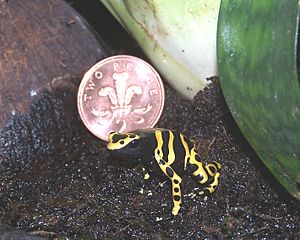Frogs as pets facts for kids
Frogs are becoming very popular pets! They are often called "exotic pets" because they are not common pets like cats or dogs. Compared to reptiles, frogs are usually easier to care for. They don't cost a lot of money, and it's easy to find food for them. Some popular types of pet frogs include true frogs, tree frogs, toads, and poison dart frogs.
Pet frogs eat many different kinds of live food. Small frogs might eat tiny crickets, fruit flies, or other small bugs. Medium-sized frogs can enjoy bigger crickets, mealworms, or even small fish. If you have a very large frog, like a Pacman frog, it might eat small fish, other frogs, or even tiny mice or rats.
Every frog needs a special home called a terrarium. The size and type of terrarium depend on the frog. For example, tree frogs love to climb! Their tanks need a secure lid so they don't jump out. Some frogs live partly in water and partly on land. Their terrariums need both a water area and a land area. Frogs from tropical places need their homes to be humid and misty. It's very important to treat all the water you give your frog. Tap water often has chlorine, which can harm or even kill frogs. Many pet stores that sell reptiles also sell pet frogs.
Contents
What Do Pet Frogs Eat?
Pet frogs need to eat live food. The type and size of food depend on how big your frog is.
Food for Small Frogs
- Tiny crickets
- Fruit flies
- Springtails
- Other small bugs
Food for Medium Frogs
- Larger crickets
- Mealworms
- Butterworms
- Silkworms
- Grasshoppers
- Small fish
Food for Large Frogs
- Small fish
- Other frogs
- Small reptiles
- Small mammals, like mice or rats
Where Do Pet Frogs Live?
The home for your frog is called a terrarium. The size of the terrarium depends on your frog's size and how active it is.
Terrarium Sizes
- Small or slow frogs: A terrarium about 60 cm long, 30 cm wide, and 30 cm high is often enough.
- Active frogs (like poison dart frogs): Even though they are small, these frogs like to climb. They need a bigger home, around 1 meter long, 60 cm wide, and 60 cm high.
- Large frogs: Very big frogs might need a terrarium that is 1 meter long, 1 meter wide, and 1 meter high.
Special Terrarium Needs
- Climbing frogs: Frogs that climb, like tree frogs or poison dart frogs, can stick to glass. Their terrariums must have a very secure lid to stop them from escaping.
- Airflow: Tropical frogs need fresh air. Their cages should have metal mesh on at least two sides to let air move through.
- Moisture: All pet frogs need moisture. You can use a special fog machine or spray the tank with a hand-held bottle. Frogs from jungles need misting at least twice a day. Frogs from drier places don't need as much.
- Water pools: Always provide a clean pool of water for your frog. It's very important to use bottled water or water that has been treated to remove chlorine. Chlorine in tap water can be very harmful to frogs.



